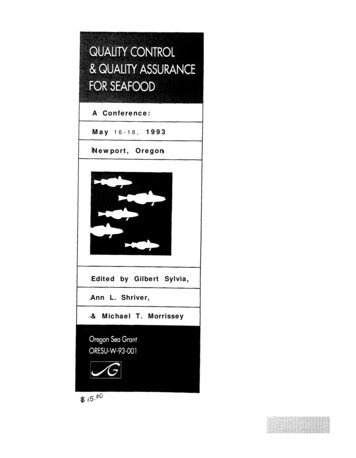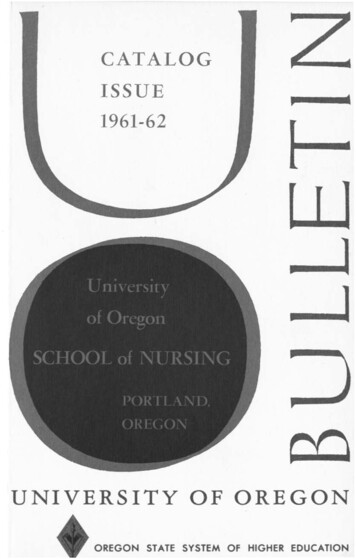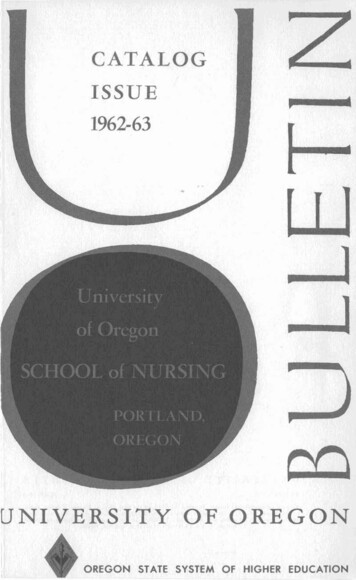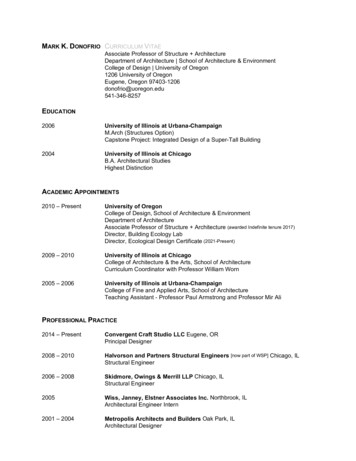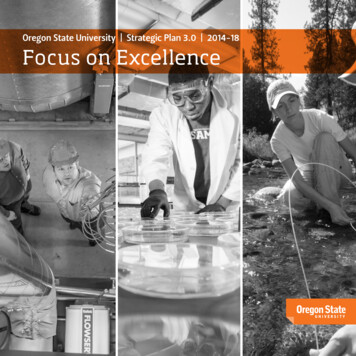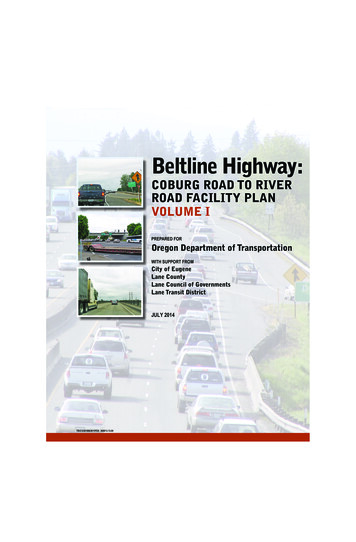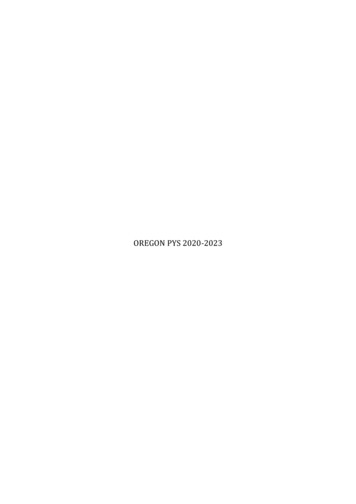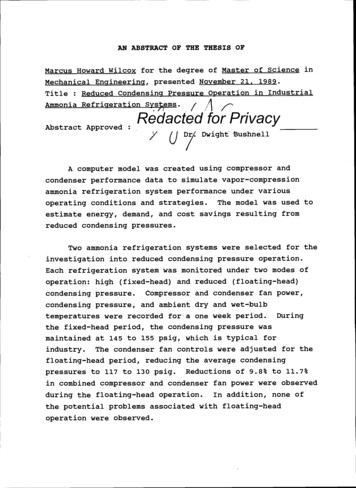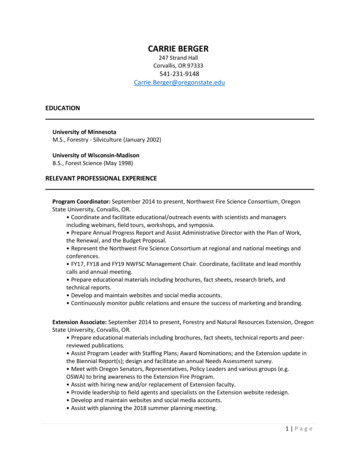
Transcription
CARRIE BERGER247 Strand HallCorvallis, OR ATIONUniversity of MinnesotaM.S., Forestry - Silviculture (January 2002)University of Wisconsin-MadisonB.S., Forest Science (May 1998)RELEVANT PROFESSIONAL EXPERIENCEProgram Coordinator: September 2014 to present, Northwest Fire Science Consortium, OregonState University, Corvallis, OR. Coordinate and facilitate educational/outreach events with scientists and managersincluding webinars, field tours, workshops, and symposia. Prepare Annual Progress Report and Assist Administrative Director with the Plan of Work,the Renewal, and the Budget Proposal. Represent the Northwest Fire Science Consortium at regional and national meetings andconferences. FY17, FY18 and FY19 NWFSC Management Chair. Coordinate, facilitate and lead monthlycalls and annual meeting. Prepare educational materials including brochures, fact sheets, research briefs, andtechnical reports. Develop and maintain websites and social media accounts. Continuously monitor public relations and ensure the success of marketing and branding.Extension Associate: September 2014 to present, Forestry and Natural Resources Extension, OregonState University, Corvallis, OR. Prepare educational materials including brochures, fact sheets, technical reports and peerreviewed publications. Assist Program Leader with Staffing Plans; Award Nominations; and the Extension update inthe Biennial Report(s); design and facilitate an annual Needs Assessment survey. Meet with Oregon Senators, Representatives, Policy Leaders and various groups (e.g.OSWA) to bring awareness to the Extension Fire Program. Assist with hiring new and/or replacement of Extension faculty. Provide leadership to field agents and specialists on the Extension website redesign. Develop and maintain websites and social media accounts. Assist with planning the 2018 summer planning meeting.1 Page
Staff Scientist: April 2009 to September 2012, Cardno ENTRIX, East Lansing, MI Coordinated and facilitated meetings with clients, trustees, and ecologists. Coordinated chemical and biological sample analyses with analytical laboratories andassisted with quality assurance reviews and documentation. Led research reviews and performed needs assessments. Designed, created, and managed databases used to manage thousands of laboratory andfield samples, as well as supporting documentation for each sample. Designed and created database queries and prepared analytical data for use intechnical reports and peer-reviewed publications. Contributed to the development of technical reports, including writing and editing.Senior Faculty Research Assistant (Ecology/Silviculture): July 2007 to March 2009, Department ofForest Science, Oregon State University, Corvallis, OR. Promoted to Senior Faculty Research Assistant through the Promotion and Tenure process atthe College of Forestry, July 2007. Coordinated and facilitated outreach meetings with OSU faculty and agency professionals. Analyzed and interpreted complex ecological and biological datasets (e.g.,multivariate analyses) using database and statistical software. Communicated results through peer-reviewed publications, reports, and agency meetings. Developed and maintained websites for forest management projects and affiliatedfaculty, staff, and graduate student profiles.Faculty Research Assistant (Ecology/Silviculture): December 2002 to July 2007, Department ofForest Science, Oregon State University, Corvallis, OR. Led the design and implementation of forest management and silviculture researchfield studies. Organized and facilitated field tours and workshops for stakeholders and agencyprofessionals. Developed and maintained websites for forest management projects and affiliatedfaculty, staff, and graduate student profiles. Collected overstory tree and understory vegetation data including vascular plant surveysand identification. Managed, analyzed, and interpreted overstory tree and understory vegetation datausing database and statistical software. Communicated results through presentations and posters at national andinternational conferences and departmental and agency seminars, agency meetings,peer-reviewed publications, and quarterly progress reports. Coordinated field crews, travel arrangements, and maintenance and acquisition ofequipment for various forest management projects. Hired, supervised, and trained seven technicians and supervised a six person inmate crew. Traveled within the PNW region and worked in inclement weather and difficultmountainous terrain.Research Ecologist: January 2002 to December 2002, USDA Forest Service, Rocky MountainResearch Station, Fort Collins, CO. Led the design and implementation of forest regeneration research field studies. Collected overstory tree and understory vegetation data including vascular plant surveysand identification.2 Page
Managed and analyzed data related to fire, regeneration, and white pine blister rustusing database and statistical software. Participated in regional agency meetings. Coordinated field crews, travel arrangements, and maintenance and acquisition of equipment. Hired, supervised, and trained three technicians. Traveled within the Rocky Mountain region and worked in inclement weather anddifficult mountainous terrain.Graduate Research Assistant: January 2000 to January 2002, Department of Forest Resources,University of Minnesota, St. Paul, MN. Led the design and implementation of a forest regeneration research field study. Collected overstory tree and understory vegetation data including vascular plant surveysand identification. Managed, analyzed, and interpreted data related to harvest intensity, fire, andregeneration using database and statistical software. Communicated results through presentations at departmental and agency seminars,posters at national and international conferences, and peer-reviewed publications. Hired, supervised, and trained four technicians. Traveled within Alberta, Canada and worked in remote areas under inclement weatherand difficult terrain.Teaching Assistant (Forest Ecology (FR 3104)): Fall semester 2000, Department of ForestResources, University of Minnesota, St. Paul, MN. Led class discussions, presented two lectures, graded papers and exams, held office hours,and co-taught two weekend field sessions.Biological Technician: June 1998 to December 1999, Department of Forest Ecology andManagement, University of Wisconsin-Madison and USDA Forest Service, North CentralExperiment Station, Rhinelander, WI. Collected and managed tree physiology research field data. Communicated results at a national conference. Supervised two technicians.Undergraduate Research Assistant: November 1996 to May 1998, Department of Forest Ecologyand Management, University of Wisconsin, Madison, WI. Assisted with field work and processed plant and soil samples. Collected and assessed forest productivity data using a National Science FoundationResearch Experience for Undergraduates grant award. Assisted with implementation of the large-scale Free Air Carbon Enrichment project (FACE).3 Page
OTHER RELATED EXPERIENCE Community Emergency Response Team (CERT) Training, April 2019-June 2019Leadership Development Program for Executives, December 2018-current (ends in September2019)Oregon State University’s Fierce Conversations Training, 2016Skyline West Neighborhood Firewise Chair, 2015-currentFreelance writer and photographer, Pacific Island Living magazine, New Caledonia, 2013Blogger, New Caledonia, 2011-2013SPECIALIZED SKILLS AND KNOWLEDGESoftware/Programs/Social media: Microsoft Office Word, Excel, PowerPoint, Access, and FrontPage; Pachyderm; Drupal; Adobe InDesign; Blogspot; HTML web design; Facebook; Twitter;Google Calendar; SurveyMonkey; MailChimp; WebEx; Zoom; Adobe Connect; Google Earth; SAS;Jump; PC-ORD; Sigma Plot; ProCite; EndNote; MapSource; ORGANON; Landscape ManagementSystem (LMS); SORTIE.Equipment: Haglof Vertex III Hypsometer; Tripod Data Systems Recon Pocket PC; Fisheye Lens;Hobo datalogger; Impulse 2000 Laser; soil moisture probe; Garmin GPS; Silva compass; LiCOR6400; AccuPAR; spectrophotometer; most forest mensuration tools (e.g., dbh tape, prism, andclinometer).Plant Taxonomy: Experience and knowledge of vascular plant taxonomy and plant characteristics inthe upper Great Lakes Region, Canada (boreal forest flora), Colorado (Rocky Mountain flora), andthe Pacific Northwest (Coast Range flora).PEER-REVIEWED PUBLICATIONS1. Berger, C., L. Grand, S.A. Fitzgerald, D. Leavell. 2018. What is fire severity? EM9222, Extension &Experiment Station Communications, Oregon State University. 2p.2. Berger, C., S.A. Fitzgerald, D. Leavell, J. Peterson. 2018. Air quality impacts from prescribedfire and wildfire: How do they compare? EM9203, Extension & Experiment StationCommunications, Oregon State University. 2p.3. Baylog, K., D. Leavell, C. Berger. 2018. How can landscapes with mixed ownerships bemanaged for fire effectively? EM9196, Extension & Experiment Station Communications,Oregon State University. 2p.4. Fitzgerald, S.A., C. Berger, D. Leavell, L. Grand. 2018. Salvage cutting: What are the effects onfire behavior and severity? EM9195, Extension & Experiment Station Communications,Oregon State University. 2p.4 Page
5. Bennett, M., S.A. Fitzgerald, D. Leavell, C. Berger. 2018. Have the size and severity of forestwildfires increased in Oregon and across the West? EM9194, Extension & Experiment StationCommunications, Oregon State University. 2p.6. Berger, C., S.A. Fitzgerald, D. Leavell. 2018. Managing wildfire for resource benefit: What is itand is it beneficial? EM9193, Extension & Experiment Station Communications, Oregon StateUniversity. 2p.7. Leavell, D., C. Berger, S.A. Fitzgerald, B. Parker. 2017. Fire Science Core Curriculum. EM9172,Extension & Experiment Station Communications, Oregon State University. 197p.8. Strong, N., P.T. Oester, D.C. Shaw, B. Saffell, T. Fegel, C. Berger. 2017. Pest Scene Investigator:A Training Curriculum. EM9161, Extension & Experiment Station Communications, OregonState University. 48p.9. Berger, C. and T. Fegel. 2017. Nontimber forest products for small woodland owners: Bigleafmaple syrup. EM9163, Extension & Experiment Station Communications, Oregon StateUniversity. 2p.10. Fegel, T. and C. Berger. 2017. Nontimber forest products for small woodland owners:Shiitake mushrooms. EM9162, Extension & Experiment Station Communications, OregonState University. 2p.11. Wolf, R., C. Berger, J. Creighton and C. Olsen. 2015. Not all fires are wild: Understandingfire and its use as a management tool. EM9114: 1-6. ANREP Gold Award for Short Publication.12. Puettmann, K.J., E.K., Dodson, A. Ares and C.A. Berger. 2013. Short-term responses ofoverstory and understory vegetation to thinning treatments: a tale of two studies. In:Anderson, P.D., Ronnenberg, K.L., eds. Density management in the 21st century: west sidestory. Gen. Tech. Rep. PNW-GTR-880. Portland, OR: US Department of Agriculture, ForestService, Pacific Northwest Research Station: 44-58.13. Berger, C.A., J. McKenna and K.J. Puettmann. 2012. Understory response to repeatedthinning in Douglas-fir forests of western Oregon. Journal of Sustainable Forestry 31(6): 589605.14. Puettmann, K.J. and C.A. Berger. 2006. Development of tree and understory vegetation inyoung Douglas-fir plantations in western Oregon. Western Journal of Applied Forestry 21(2):94-101.15. Berger, C.A. and K.J. Puettmann. 2005. Development of stand structure in young Douglas-firplantations. Pp. 65-68 IN: Balancing Ecosystems Values, Innovative Experiments forSustainable Forestry. USDA Forest Service, Pacific Northwest Research Station, GeneralTechnical Report PNW- 635. 389 p.16. Gilmore, D.W. and C.A. Berger. 2004. White spruce basal area as a predictor of seed rainduring an exceptional seed year in northwestern Alberta. Northwest Science 78(1): 75-78.5 Page
17. Berger, C.A. and D.W. Gilmore. 2003. Germination and survival of spruce seedlings followingfire in northwestern Alberta. Northern Journal of Applied Forestry 20(1): 45-47.PRESENTATIONSTalks:1. Berger, C.A. May 2018. Changing the culture of fire through sound science andinnovative programming. Association of Natural Resource Extension ProfessionalsConference, Biloxi, MS.2. Leavell, D. and C.A. Berger. April 2018. FNR Extension Fire Program. OR and WAPrescribed Fire Council Meeting, Hood River, OR.3. Leavell, D. and C.A. Berger. February 2018. Fire Science Core Curriculum, FirePrevention Module. Oregon Fire Prevention Workshop, Ashland, OR.4. Berger, C.A. January 2006 & 2007. SORTIE (forest modeling program). Guest Lecturerfor Fundamentals of Silviculture (FS 533), Corvallis, OR.5. Berger, C.A. and K.J. Puettmann. May 2006. Young Stand Management Study Overview. WestOregon District Reforestation Peer Review Tour: “Creating the Pathway to Complex Structure inNon- Complex Stands”, Philomath, OR.6. Berger, C.A. and K.J. Puettmann. June 2005. Utilizing gaps to encourage diversity inplantation forests. 5th North American Forest Ecology Workshop, Aylmer, Quebec, Canada.7. Puettmann K. J. and C.A. Berger. March 2004. Young stand management. Oregon StateForest Meeting, Corvallis, OR.8. Berger, C.A. and K.J. Puettmann. November 2003. Development of stand structure inyoung Douglas-fir stands: Preliminary findings. Young Stand Management Workshop,Corvallis, OR.9. Berger, C.A. March 2002. Effects of harvest intensity and forest cover type on white spruce seedrain, germination, and survival in northwestern Alberta, Canada. Ecology and Ecophysiology ofWhite Pines meeting, Fort Collins, CO.10. Berger, C.A. December 2001. Effects of harvest intensity and forest cover type on whitespruce seed rain, germination, and survival in northwestern Alberta, Canada. M.S. seminar,Department of Forest Resources, University of Minnesota, St. Paul, MN.11. Becker*, C.A. and D.W. Gilmore. April 2001. Effects of harvesting intensity and forest cover typeon white spruce and paper birch seed rain and regeneration in northwestern Alberta, Canada.Ecosystem Management by Emulating Natural Disturbance Workshop, Edmonton, Alberta.6 Page
12. Becker*, C.A., E.P. McDonald, E.L. Kruger, and J.G. Isebrands. February 2000. Interactingeffects of elevated CO2 and tropospheric O3 on leaf level responses of temperate trees in northernWisconsin. Forestry Seminar, Department of Forest Resources, University of Minnesota, St. Paul,MN.Posters:1. Kooistra, C., A. Ellison, C. Moseley, G. Johnson, J. Creighton, C. Berger. 2018. Understandingregionally specific scientific research and information use and needs in Oregon andWashington. Fire Continuum Conference, Missoula, MT.2. Creighton, J.C., C. Berger, and J. Johnson. May 2018. Analysis of current educationalprograms for Oregon woodland owners. Association of Natural Resource ExtensionProfessionals Conference, Biloxi, MS.3. Berger, C.A. and K.J. Puettmann. June 2007. Structure based management in young Douglasfir plantations. 6th North American Forest Ecology Workshop, Vancouver, BC, Canada.4. Berger, C.A. and K.J. Puettmann. June 2005. Development of tree and understory vegetationin young Douglas-fir plantations. IUFRO 5th International Conference on Forest VegetationManagement: Useable Science, Practical Outcomes and Future Needs, Corvallis, OR.5. Berger, C.A. and K.J. Puettmann. April 2005. Development of stand structure in young Douglasfir plantations. Conference: Science and the Northwest Forest Plan, Knowledge Gained Over aDecade, Portland, OR.6. Berger, C.A. and K.J. Puettmann. August 2004. Development of stand structure in young Douglasfir plantations. Balancing Ecosystem Values International Workshop, Portland, OR.7. Becker*, C.A. and D.W. Gilmore. August 2001. Effects of harvesting intensity and forest covertype on white spruce seed rain and regeneration in northwestern Alberta. Ecological Society ofAmerica Conference, Madison, WI and the North American Forest Ecology Workshop.8. Becker*, C.A. and D.W. Gilmore. June 2001. Effects of harvesting intensity and forest cover typeon white spruce and paper birch seed rain and regeneration in northwestern Alberta, Canada. 3rdNorth American Forest Ecology Workshop, Duluth, MN.9. Becker*, C.A., E.P. McDonald, E.L. Kruger, and J.G. Isebrands. August 1999. Interacting effectsof elevated CO2 and tropospheric O3 on leaf level responses of temperate trees in northernWisconsin. Ecological Society of America Conference, Spokane, WA.*Note name change from Becker, C.A. to Berger, C.A.7 Page
Selected Workshops:1. Leavell, D. and C. Berger. October 2018. Fire workshop, WOWnet Retreat, Mollala, OR2. Leavell, D. and C. Berger. May 2018. Teaching the Oregon State University Fire ScienceCore Curriculum. Fire Continuum Conference, Missoula, MT3. Fegel, T. and C. Berger. November 2017. Maple sugaring workshop4. Fegel, T. and C. Berger. June 2017. Shiitake mushroom workshop5. Fegel, T. and C. Berger. March 2017. Shiitake mushroom workshop. Tree School,Clackamas County, ORPROFESSIONAL SERVICES Search Committee for Continuing and Professional Education Coordinator, January2018, Oregon State University, OR College of Forestry Advisory Council to the Dean, October 2006 -June 2008, OregonState University, Corvallis, OR. Research Support Faculty work group, February 2007-June 2008, Oregon State University,Corvallis, OR. Faculty Research Assistant Representative to the Forestry Leadership Team, March 2006October 2006, Oregon State University, Corvallis, OR. Search Committee for Faculty Research Assistant (Silviculture/Forest Ecology), 2008, OregonState University, Corvallis, OR. Search Committee for Post-Doctoral Research Associate (Silviculture/Forest Ecology), 2003,2005, 2006, 2007, Oregon State University, Corvallis, OR. Wood Magic volunteer, September 2006, Oregon State University, Corvallis, OR. Adopt-A-Highway clean-up coordinator, spring/fall 1999, USDA Forest Service, NorthCentral Station, Rhinelander, WI and summer 1996, Devil’s Lake State Park, Baraboo, WIAWARDS Awesome Force Award, Forestry & Natural Resources Extension Program, 2017 Dean’s Award for Outstanding Achievement in Extended & Continuing Education, 2016 ANREP Gold Award for Short Publication, 20158 Page
Assist Program Leader with Staffing Plans; Award Nominations; and the Extension update in the Biennial Report(s); design and facilitate an annual Needs Assessment survey. Meet with Oregon Senators, Representatives, Policy Leaders and various groups (e.g. OSWA) to bring awareness to the Extension Fire Program.

